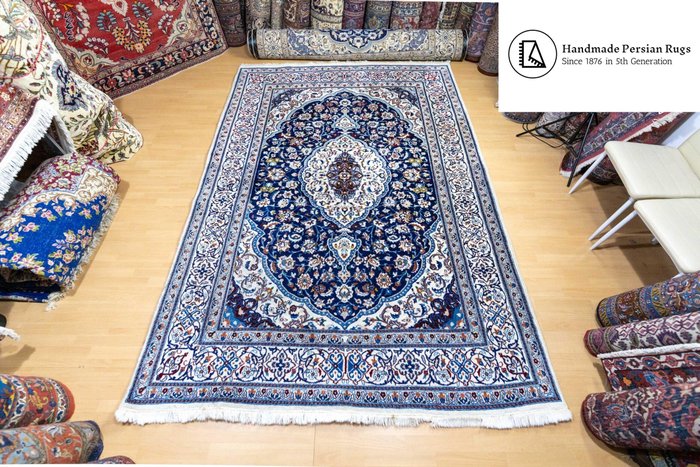
Nain - Teppich - 235 cm - 157 cm
Nr. 83509153

Nr. 83509153

Knot density: 12La (12 yarn layers), approx. 250.000 knots/sqm
Pattern: Lachak Toranj Nain Medallion
Origin: City of Nain, Iran
Condition: Very good with minimal patina, extensively restored, professionally washed
Material: pile 100% - warp 100% cotton
Luxurious and precious
Handknotted Nain or Naeen rugs are the highest quality rugs made in and around the city of Nain in the province Isfahan are hand-knotted in central Persia. Nain rugs are known for their very formal look, where the colors baby blue, navy blue, beige and burgundy often dominate. Nain rugs are the best choice for a formal living room, dining room, bedroom and entryway. Nain rugs are ideal for hallways and stairwells.
It is one of the most beautiful carpets in the world, if not the most beautiful, and the Nain name alone makes it famous. These beautiful rugs are made in and around the city of Nain which is located in central Iran about 60 miles east of the beautiful city of Isfahan. Highly valued by lovers of Persian carpets, Nain carpets are characterized by precise delicacy and supreme beauty. A perfect ratio of silk and wool is primarily used in these rugs to create a coating that amazes the beholder and inspires admiration from around the world.
History of the Nain carpets
Although Nain is not a very old carpet weaving town, it is well established and is one of the most popular carpet production centers in the world Iran. She inherited most of her skills from the very old and neighboring city of Isfahan, which also produces very beautiful carpets. The customs and traditions here have hardly changed in the last century. For many generations, up until just before World War II in the 1930s, the people of Nain produced high quality handmade woolen fabrics that were used to make traditional religious and secular clothing and fine woolen overcoats. After the war, Iranians started making carpets of the highest quality. After the war, Iranians began to adopt Western clothing styles and the market for the fabrics made in Nain declined. Thus, the highly developed knowledge and skills of the Nain textile industry were transferred to the production of handmade carpets. Nain's reputation for weaving of the highest quality has been restored in modern times.
Construction of Nain carpets
Nain rugs are hand-knotted by skilled knotters who take several years to complete a single rug. Although very similar to Isfahan rugs, Nain rugs are easily recognized by their distinctive coloring and smooth, well-cut pile. Nain rugs typically feature a sweeping, arabesque floral design in blue, green, and white on a warm beige or ivory background. Nain with more than 300-500 knots per square inch are not uncommon. Only excellent quality wool and silk are used on a base fabric of fine cotton or silk. The Nain rug is a precious treasure that brings elegance to any room and its beauty will forever remain priceless.
About Nain Persian carpets
The city of Nain (also called Naeen) with an area of 35.000 sq km is located 130 km east of Isfah.
east of the city of Isfahan and 320 km south-east of Tehran. E
is located in the central plateau of Iran, in the province of Isfahan. The climate in Nain is hot and dry.
and dry. This city has many famous villages and fountains.
The historic city of Nain is ancient and a relic from pre-Islamic times. In the
Islamic geography books of the 1st century, e.g. `Hodudol Alam` (372
AH.) there are some notes that reveal the name with some characteristics of this city.
characteristics of this city. The most important historical relic of Naein is the `Narenj` or `Narin`.
the castle. The architecture and way of life of this desert community is very interesting and surprising.
It's very interesting and surprising.
The town of Nain is world famous for its magnificent carpets. The history of the precious wool and the woven one
The history of wool and textile fabric goes back centuries, but carpet production is relatively recent, dating back less than a century.
The manufacture of carpets is relatively new, dating back less than a century. All Nain rugs have asymmetrical knots (
Persian), wool pile and cotton warp. They are cut tight to enhance their looks.
In some cases, silk chains are also used. For carpets with higher and finer knots, cork (sheep's wool) is used for the pile.
sheep's wool) used for the pile. The use of silk borders around flowers and arabesques is common.
"Errors and errors excepted"
So kaufen Sie auf Catawiki
1. Etwas Besonderes entdecken
2. Höchstgebot abgeben
3. Sichere Zahlung durchführen